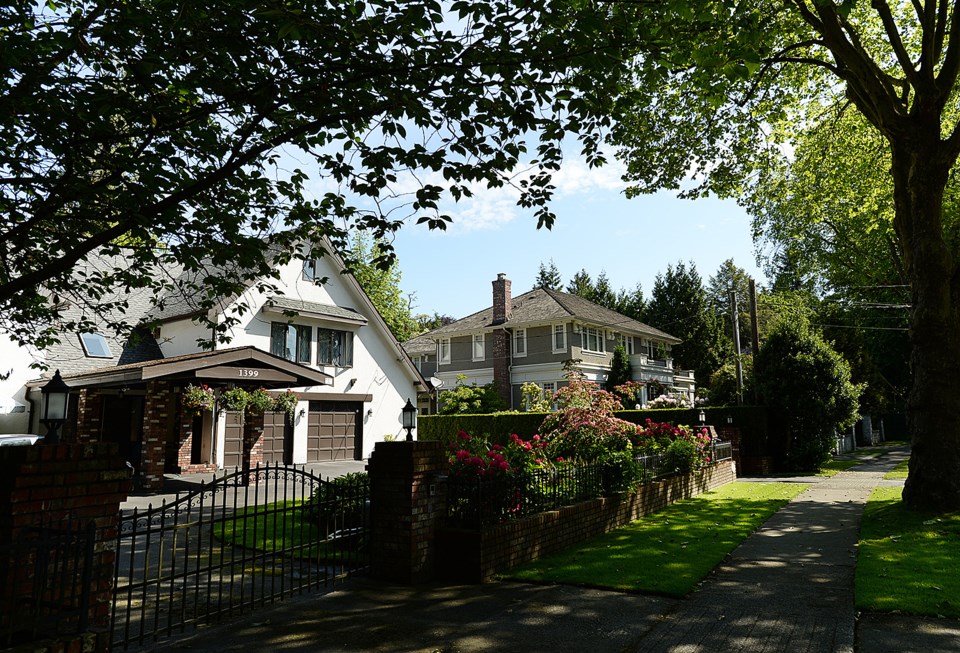Knocking down Vancouver’s older homes might become more difficult if staff recommendations in two reports going before city council June 10 are adopted.
Recommendations in the first report propose a one-year prohibition on demolishing pre-1940 homes in the First Shaughnessy District, which stretches between 16th and 25th between Oak and East Boulevard, so the city can complete a review of the area’s official development plan.
The one-year “heritage control period” would enable the city to determine what steps can be taken to conserve heritage property in the district.
There are 595 properties in First Shaughnessy, according to the report, of which 329 were constructed before 1940. Eighty of the properties are listed on the Vancouver Heritage Register. Of the 80, only 11 are protected from demolition through heritage designation and/or a heritage revitalization agreement.
A city review of demolitions over the past five years revealed that of all the single-family homes demolished, 40 per cent were houses built before 1940.
Such houses are typically smaller than the size permitted in the existing zoning and some don’t have amenities buyers expect.
A second report going for council proposes that anyone knocking down a pre-1940 home would have to divert 75 per cent of waste from the landfill, while anyone knocking down a pre-1940 home identified as a character building would have to divert 90 per cent of the waste from the landfill.
“Last December, mayor and council approved our heritage action plan and in that these tasks were identified as things we needed to explore,” deputy city manager Sadhu Johnston told the Courier.
Pre-1940 homes are considered to have “character” because they have surviving architectural features and the wood is generally old-growth, which is now hard to find and can be valuable for reuse.
“If you are going to take down a home, we want to keep these materials out of the landfill, so we want to make it more difficult to take down these homes, but if you are going to do it, we want to keep these materials from the landfill and hopefully keep them in productive use. The wood, the windows, the doors — it’s just amazing materials in these structures and we don’t want to lose them to the landfill,” Johnston said.
It would take extra time to salvage materials and add about 15 per cent to demolition costs. Johnston estimates the cost to demo a typical single-family home at about $15,000 to $16,000.
“This is a bit of a test for us. We’re trying to align our heritage preservation efforts with our obligations under Metro’s requirements for keeping clean wood waste out of the landfill and our desire for the greenest city action plan to keep the material out of the landfill,” he added. “So we’re trying to align council’s priorities and hope we can achieve both of these with this effort and maybe even create green jobs in the process.”
The city will track the results to see if they prevent demolition of older homes and how much material is saved from the landfill.
Elizabeth Murphy, a spokesperson from the Vancouver Character House Network, says while the recommendations are a step in the right direction, she still has several concerns.
She said many areas of the city were built in the 1940s and those houses should also be protected.
Johnston said the city may look at a phased approach “where we try this for a year and we’ll report back to council and say, this is great, now let’s do the ’40s as well. We also looked into the numbers of buildings being taken down and the pre-1940s were a large segment of these. So it’s a starting place. It may not be perfect.”
Murphy also noted that there’s nothing in the proposals that deal with the building code, which she said is biased towards new construction.
“For instance, rain-screening the existing exterior walls of the character houses should not be required. Also, when a house is moved it should not be required to be brought up to full current code compliance,” she told the Courier.
Johnston said staff will look at some of these issues in the next update to the building code.
“We are responding to the concerns that our mayor and council have expressed to us as staff and we’re going to be tracking to see if this does stem the tide of the loss of these types of homes in our communities, so we definitely see this as one step in many that need to be taken to address this area of concern,” he said.
noconnor@vancourier.com
twitter.com/naoibh



